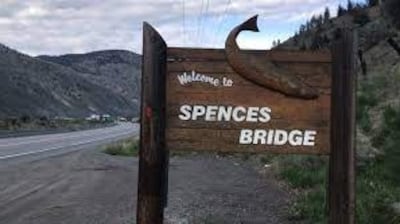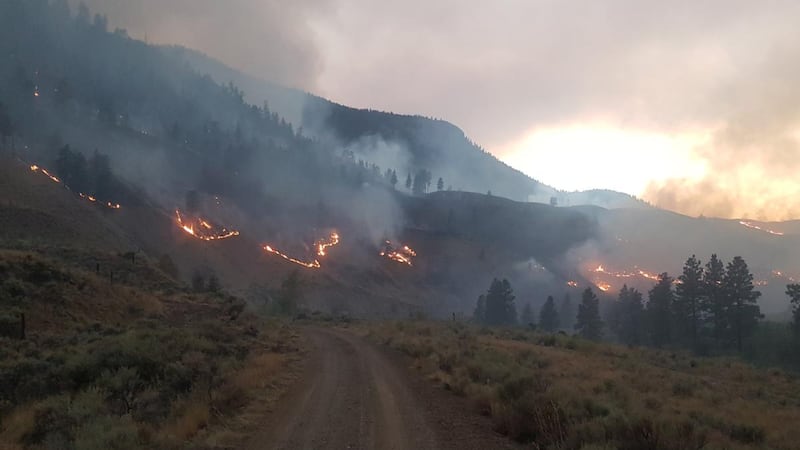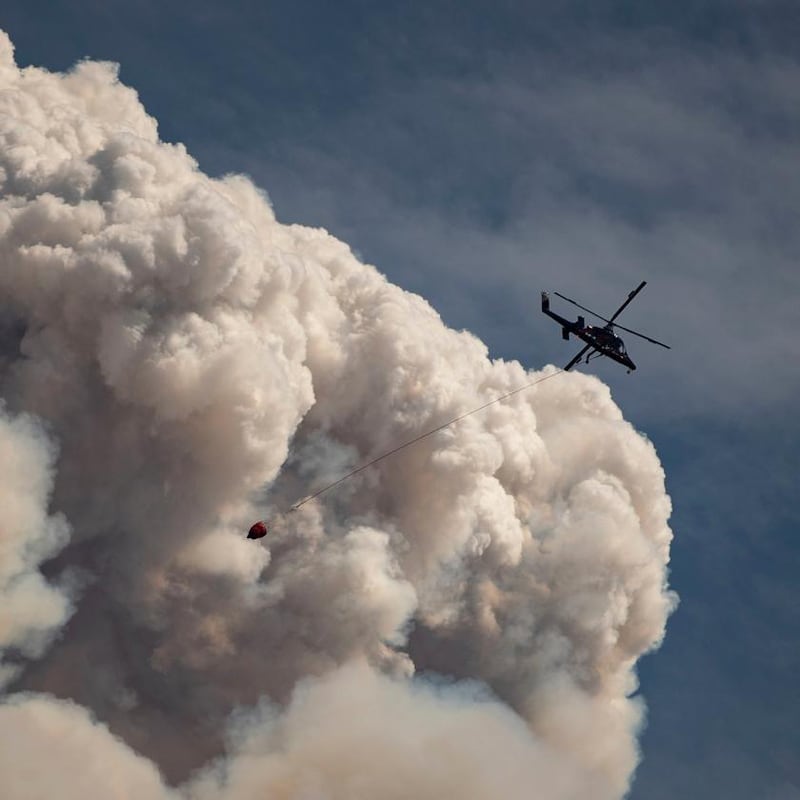Jim Ryan, who is from Blackrock in Co Dublin, moved to Canada in 1980. For most of that time he has lived in the small British Columbia town of Spences Bridge – population 150 – in the driest and hottest region of Canada. When the nearby community of Lytton set a heat record of 49.6 degrees and the next day burned to the ground, it made news around the world. It wasn't long before the Lytton fire reached Spences Bridge
We were all set to leave on a two-week canoe trip to the eastern part of British Columbia. Our plan was to head out first thing on Wednesday, July 21st. It was a bit smoky from the flames that had engulfed the village of Lytton. The fire still lurked on the plateau above us, but it hadn’t seemed threatening for the previous couple of weeks. We had become used to not thinking about it.
That morning the Lytton fire picked up speed and headed in our direction. We delayed our departure to see what would happen. We were still hoping to go on our trip, but quickly we realised that this was wishful thinking. That morning, with the fire about 5km away, our local government issued an evacuation order for our community. The message was simple: get out now.
We live in a hot, dry area of Canada, in the rain shadow of the coastal mountains. There is an average 25cm of rain a year, and summer temperatures regularly reach the high 30s or low 40s. Cactus is our ubiquitous weed
Many people left. My wife, Mavourneen, a native of Killarney, Manitoba, went to stay with our daughter's family in nearby Kamloops. For the previous three years I had tried to prepare for this situation by removing all flammable material from our property. Because our home is by the Nicola River, I would be able to pump water from the river and keep the place well soaked. I decided to stay put.
We live in a hot, dry area in the rain shadow of the coastal mountains. There is an average 25cm of rain a year – in Ireland, for comparison, the annual average ranges from about 85cm in the east to 120cm in the west – and summer temperatures regularly reach the high 30s or low 40s. Cactus is our ubiquitous weed, and few trees grow on the south-facing slopes in the valley bottom, but on the plateau above us there are lots of trees.

By Friday, July 23rd, the fire was only a couple of kilometres away. The Structure Protection Unit, or SPU, paid me a visit. Comprising professional firefighters from around the province, the SPU provides and sets up sprinklers, pumps and hoses around dwellings threatened by wildfires. The British Columbia Wildfire Service also showed up to determine what sort of firebreaks or back-burning might be necessary.
For most of Friday night I stayed up and watched the huge red glow of the fire as it approached the top of the hill above the house.
On Saturday the fire-protection machine kicked into gear. First to show up was a guy in a skidder, a large machine for making logging roads and hauling logs out of the bush. Within an hour he had dug a firebreak all around the property. Then a wildfire crew from the British Columbia Wildfire Service arrived and laid out more than 300m of hoses. They began to hose down everything. The SPU crew from the day before returned to turn on the pump and sprinklers.
Soon our house was wrapped in a veil of water. Looking at all the resources that had been summoned to help us brought me very near to tears. But we weren’t special: the SPU was doing the same for all houses in the line of the fire. In the nearby village of Spences Bridge, every house had been equipped with sprinklers.
During the night my neighbour called to say the fire was coming down the hill towards my house. Our defences were about to be put to the test
By the time the SPU left I certainly felt a lot more confident in the face of the fire that was coming down the hill towards my house. Even when the fire crew soaking down the property got called away to a critical emergency up the valley, I felt safe. Maybe ignorance is bliss. Between the work done by the SPU, the wildfire service and the brush-clearing that I had done myself, I felt ready for whatever the fire would bring.
Ultimately, the future of our house depended on the wind. As the hours passed, the fire moved across the mountainside about 100m above me. A slight breeze gently blew it towards the indigenous community of Kumsheen, a couple of kilometres away. Then the winds changed. The fire came back my way. It was burning a little lower down the side of the hill. At this level on the hills, however, there are few trees. It was mostly grass and sage brush that was burning. With light winds the fire had begun to behave like a well-managed grass burn. It stopped at the gully about 200m from our house. Then it headed back up the mountain.
I went to bed, planning to get up hourly to check on the fire and the sprinklers. Just before my second check my neighbour called to say the fire had come up out of the gully and was coming down the hill towards my house. Our defences were about to be put to the test.

As the flames approached the firebreak 100m from the house, the wind suddenly changed again. It sent the fire back in the direction from which it had just come. It was as if Mother Nature had taken a personal interest in our wellbeing and was carefully managing the fire to burn off debris while never threatening us directly. At about 4 am the firefighters returned to finish burning any debris that Mother Nature might have missed. I went to bed.
When I got up next morning it was all over. The closest the fire had got to us was about 100m. Now the little green oasis that is our home is surrounded by a charred and smouldering landscape.
The fire continues to burn and spread, and firefighting resources have been directed elsewhere. The SPU worked with the folks from Kumsheen to do a major burn around the indigenous community there. It was also on standby as the flames raced down the hill towards the village of Spences Bridge, but once again the winds were kind. The fire backed away.
The fire will continue to threaten and spread to other homes and communities. Since the fire first started in Lytton, on July 1st, it has annihilated that small town and burned more than 35,000 hectares of forest. The Lytton fire is only one of hundreds in the province and one of thousands burning across the entire west side of North America. Add to that the thousands of fires burning in Siberia and tens of thousands, if not millions, of tons of carbon must be being released into the atmosphere each day. This carbon doesn’t show up on the official carbon footprint of any country.
Safe at last, I sat down and wrote a letter to my federal and provincial government representatives. I pointed out that people had died in their ridings, two in the Lytton fire and many more from heat in the previous record-shattering heatwave. I asked if they would put politics aside and become champions in getting our provincial and federal governments to focus on reducing carbon emissions.

The Cop 26 climate summit is coming up in Glasgow from October 31st to November 12th. We don't want it to be like the previous 25 editions of this event, where Canadian governments pledge all kinds of reductions but then do nothing. Canada is a laggard when it comes to climate change. We like to think of ourselves as a well-educated and progressive society, but underneath it all we are one of the world's worst carbon polluters. We have the worst record of all the G7 countries in reducing our emissions.
The 49-degree temperatures we experienced in late June were scary – much more scary than the fire, because it just felt wrong. Imagine Canada recording temperatures of almost 50 degrees. We can’t continue like this. The UN Intergovernmental Panel on Climate Change’s recent assessment got to the point: global warming is already affecting every region on Earth. Action needs to be taken now. Not next year or down the road sometime. We’ve been putting this off for decades, and now our children are at risk.
The fire I have been describing took place between July 22nd and July 25th. But it lingers, and with strong winds it (and many other fires) roared back to life this week. Once again ash is dropping from the sky, and the smoke is so thick it is off the charts on any measure of pollution. This time I am not directly threatened, as most flammable material near our home has been already burned, but it would be remiss of me not to mention the professionalism of the firefighters who helped protect us. Quiet and thorough, these young men and women put our politicians to shame. I feel truly humbled when I think about them.











